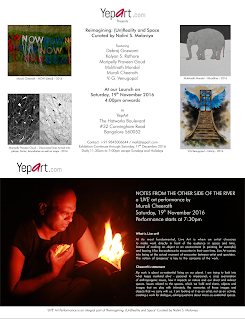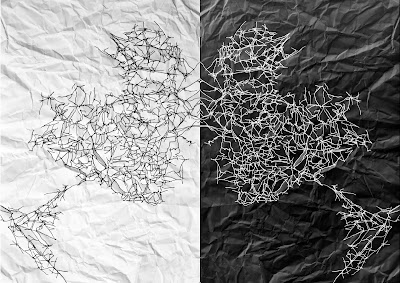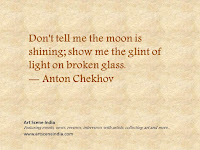Twinkle's recent body of work is inspired by Navarasa, an ancient philosophical concept originating from Bharata Muni’s Natyashastra, which forms an integral element of Indian aesthetics and artistic expression. Her series of portraits centers around the 'Rasa' theory and explores the range and depth of human emotion - the duality and complexity of situations and responses inherent in each moment of existence.
 |
| Joy Unfolded - (Hasya Rasa) |
Twinkle recently completed her master’s in fine arts from Middlesbrough, UK. Prior to that she completed her master’s in visual arts from Agra, India and studied graphic printing techniques such as etching and lithography at Bharat Bhawan, Bhopal before moving to UK.
While in India, she was eager to push the boundaries of conventional artmaking further, and began experimenting with various materials and media, in conjunction with printmaking techniques. She found tea water stains on paper intriguing; the multiple layers added physical and figurative depth to her subjects. The resultant textures and the use of an organic medium lend credence to her practice which has a strong emphasis on sustainability and eco consciousness.
The use of tea as a ‘material’ in the artmaking forms a noteworthy subtext with its colonial association, alluding to the cross-cultural exchange and historical context, especially since this new series took shape after Twinkle’s relocation to UK. The entire process of staining the paper and its outcome also act as a metaphor for life’s journey, and its travails. The blemishes and scars imprinted on faces of people, imparts character and individuality to their persona.
The multicultural environment in the UK has instinctively influenced the diverse ethnicity of the portraits in Twinkle’s 'Navarasa' series. Drawn from her observations, the artworks are a celebration of the self, while acknowledging the gamut of human emotions experienced universally.
To add context to the Navarasa philosophy - according to the Indian art and culture tradition, the nine Rasas considered to be central to human emotion are Hasya (laughter), Shringara (love or beauty), Karuna (compassion), Raudra (anger), Vira (valour), Bhayanak (fear), Bibhatsa (disgust), Adbhuta (wonder) and Shanta (peace). These form the basis of expression and communication in Indian performative and visual arts, including modern and contemporary art. The rasas act as a framework for narration - the foundation of artistic and visual construct to connect and communicate with audiences.
Twinkle locates these universal emotional constructs from Indian aesthetics and tradition amidst a larger global context. The series of portraits navigates a spectrum of human sentiment, from all-encompassing grief and sadness to buoyant radiance. The alterations in facial expressions and the effects are enhanced by strong lines and bold colours that augment the emotional states. Vibrant pinks to earthy browns convey the exuberance or sombreness of the protagonist. The portraits despite the varied multiethnic facial features and influences are relatable, and interlinked by the primeval portrayals of mood, an intrinsic human trait.
In this collection, the nine works comprise of mixed media pieces on wooden boards. A larger composite artwork consisting of portraits around the Hasya Rasa, in particular, acts as a response to, and a reflection of the other works. The current suite with its play of emotion and colour is anchored by a common thread, which has a distinct collective voice, an articulation of shared concerns and feelings.
In this collection, the nine works comprise of mixed media pieces on wooden boards. A larger composite artwork consisting of portraits around the Hasya Rasa, in particular, acts as a response to, and a reflection of the other works. The current suite with its play of emotion and colour is anchored by a common thread, which has a distinct collective voice, an articulation of shared concerns and feelings.
Through expressive form and emotive resonance, these works initiate an intimate space for reflection and empathy, accentuating the continuous import of classical 'Rasa' theory in shaping contemporary artistic discourse.
- By Nalini S Malaviya
Please share this article using the social media widgets at the bottom and do subscribe to receive regular updates from Art Scene India.
For interviews, profiles, sponsored posts and to contribute articles, contact artsceneinfo@gmail.com
Also read,
- Curating Corporate Art Collections
- Art News: Venkatappa Art Gallery: Renovation
- Art News: India Art Festival in Bangalore
- How To Write An Artist Statement
- 6 Tips On How To Approach An Art Gallery And Find Gallery Representation
- Exhibiting Art in Non-Gallery Spaces
- 5 Reasons a Good Catalogue Text is Essential for Your Art


















